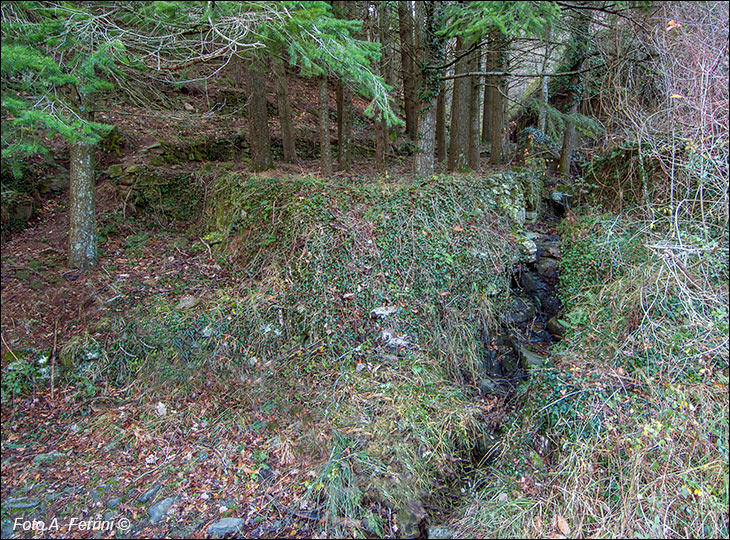Sulla via del ferro e della transumanza
itinerario sulle pendici sud Pratomagno da Pontenano al Passo della Crocina
Italiano
IN CAMMINO SU UNA VIA DELLA TRANSUMANZA 19
Fatti quattrocento metri da quando abbiamo lasciato la strada tra Pontenano e Cerreto, in fondo a una discesa, la pista forestale su cui stiamo camminando è attraversata da un piccolo corso d’acqua: il Fosso della Villa. Intanto questo toponimo ci dice che in questa zona doveva esserci una residenza signorile. Sopra strada, lungo il fosso, vediamo un muro diverso dagli altri e per come si sviluppa non può essere neanche un muro di un campo. Se ci allontaniamo qualche metro e osserviamo questa situazione leggermente dall’alto (come mostra la foto), vediamo che questo muro cinge una sorta di grande vasca, ossia una gora. A cosa poteva servire questa raccolta d’acqua? Ce lo rivela un documento del XV secolo dove si parla di una “fabbrica grossa di ferro” presente a Pontenano già nel Trecento. In questa ferriera, che era anche una fonderia, si producevano armi, prima per Arezzo, poi per Firenze. Ecco, dunque, dove siamo arrivati con questa breve passeggiata da Pontenano. Ciò è confermato da testimonianze di cacciatori che, poco sotto la strada, più volte hanno trovato materiale ferroso di forma amorfa. Sono residui di fusione, in gerco tecnico si chiamano “loppe di fusione”. La torre di cui abbiamo visto i ruderi e i muri con le enormi pietre avevano la funzione di protezione di questa preziosa ferriera che non è da escludere fosse presente anche prima del Trecento chiamandosi questa zona “Castellaccio”, termine generalmente usato per distinguere un castello più vecchio rispetto ad un altro.
After four hundred meters from when we left the road between Pontenano and Cerreto, at the bottom of a descent, the forest track we are walking on is crossed by a small stream: the Fosso della Villa. Meanwhile, this toponym tells us that there must have been a noble residence in this area. Above the road, along the ditch, we see a wall different from the others and due to the way it develops it cannot even be a field wall. If we move away a few meters and observe this situation slightly from above (as the photo shows), we see that this wall surrounds a sort of large basin, that is, a millpond. What purpose could this small dam have been used for? This is revealed to us in a 15th century document which speaks of a "large iron factory" present in Pontenano as early as the 14th century. In this ironworks, which was also a foundry, weapons were produced, first for Arezzo, then for Florence. Here, then, is where we arrived with this short walk from Pontenano. This is confirmed by the testimonies of hunters who, just below the road, have repeatedly found ferrous material of an amorphous shape. They are melting residues, in technical jargon they are called "loppe di fusione". The tower of which we saw the ruins and the walls with the enormous stones had the function of protecting this precious ironworks which cannot be excluded was present even before the fourteenth century, calling this area "Castellaccio", a term generally used to distinguish an older castle compared to another.



















































































